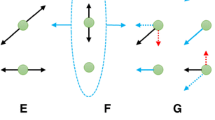Summary
A vector model in terms of four unequivocally defined proximal velocity motion vectors for the perception of all kinds of rigid motions in space, i.e. translation along and rotation around the three dimensions, was elaborated and tested empirically with simple motion patterns. The experiments were designed to test specially whether rotary motion around the sagittal axis could be included in the model. The oscilloscope generated patterns, displayed onto a translucent screen, consisted of three or four dots moving back and forth in their paths. The Ss described verbally the perceived motion. The results show that the visual system is able to analyze the different velocity vectors, including rotary motions around the sagittal axis, according to the model. Limitations of the model and lines of development were discussed.
Similar content being viewed by others
References
Börjesson, E.: Studies of visually perceived motion in depth. Unpublished doctoral dissertation, Uppsala, 1972
Börjesson, E., von Hofsten, C.: Spatial determinants of depth perception in two-dot motion patterns. Perception & Psychophysics, 11, 263–268 (1972)
Börjesson, E., von Hofsten, C.: Visual perception of motion in depth: Application of vector model to three-dot motion patterns. Perception & Psychophysics, 13, 169–179 (1973)
Braunstein, M. E.: The perception of depth through motion. Psychol. Bull. 59, 422–433 (1962)
Duncker, K.: Über induzierte Bewegung. Psychol. Forsch. 12, 180–259 (1929)
Gibson, J. J.: Optical motions and transformations as stimuli for visual perception. Psychol. Rev. 64, 288–295 (1957)
Gibson, J. J.: The senses considered as perceptual systems. Boston: Houghton Mifflin 1966
Green, B. F.: Figure coherence in the kinetic depth effect. J. exp. Psychol. 62, 272–282 (1961)
Hofsten von, C.: Proximal velocity change as a determinant of space perception. Perception & Psychophysics, 15, 488–494 (1974)
Johansson, G.: Visual motion perception: A model for visual motion and space perception from changing proximal stimulation. Report from Dept. of Psychology, University of Uppsala, No, 98, 1971
Johansson, G.: Vector analysis in visual perception of rolling motion. Report from Dept. of Psychology, University of Uppsala, No 130, 1973
Marmolin, H., Ulfberg, S.: Motion perception and form change: Quantitative studies of a projection geometric model. Unpublished report, Department of Psychology, University of Uppsala, 1967
Nakayama, K., Loomis, J.M.: Optical velocity patterns, velocitysensitive neurons and space perception: A hypothesis. Perception 3, 63–80 (1974)
Rubin, E.: Visuell wahrgenommene wirkliche Bewegungen. Z. Psychol. 103, 384–392 (1927)
Wallach, H., O'Connell, D.N.: The kinetic depth effect. J. exp. Psychol. 45, 205–217 (1953)
Author information
Authors and Affiliations
Additional information
The authors are indebted to Professor Gunnar Johansson for his valuable comments on the manuscript. The responsibility for this investigation is equally shared between the authors. This investigation was made possible by grants from the Swedish Council for Social Science
Rights and permissions
About this article
Cite this article
Börjesson, E., von Hofsten, C. A vector model for perceived object rotation and translation in space. Psychol. Res 38, 209–230 (1975). https://doi.org/10.1007/BF00308525
Received:
Issue Date:
DOI: https://doi.org/10.1007/BF00308525




